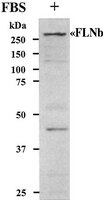Vascular and connective tissue anomalies associated with X-linked periventricular heterotopia due to mutations in Filamin A.
Reinstein, E; Frentz, S; Morgan, T; García-Miñaúr, S; Leventer, RJ; McGillivray, G; Pariani, M; van der Steen, A; Pope, M; Holder-Espinasse, M; Scott, R; Thompson, EM; Robertson, T; Coppin, B; Siegel, R; Bret Zurita, M; Rodríguez, JI; Morales, C; Rodrigues, Y; Arcas, J; Saggar, A; Horton, M; Zackai, E; Graham, JM; Rimoin, DL; Robertson, SP
European journal of human genetics : EJHG
21
494-502
2013
概要を表示する
Mutations conferring loss of function at the FLNA (encoding filamin A) locus lead to X-linked periventricular nodular heterotopia (XL-PH), with seizures constituting the most common clinical manifestation of this disorder in female heterozygotes. Vascular dilatation (mainly the aorta), joint hypermobility and variable skin findings are also associated anomalies, with some reports suggesting that this might represents a separate syndrome allelic to XL-PH, termed as Ehlers-Danlos syndrome-periventricular heterotopia variant (EDS-PH). Here, we report a cohort of 11 males and females with both hypomorphic and null mutations in FLNA that manifest a wide spectrum of connective tissue and vascular anomalies. The spectrum of cutaneous defects was broader than previously described and is inconsistent with a specific type of EDS. We also extend the range of vascular anomalies associated with XL-PH to included peripheral arterial dilatation and atresia. Based on these observations, we suggest that there is little molecular or clinical justification for considering EDS-PH as a separate entity from XL-PH, but instead propose that there is a spectrum of vascular and connective tissues anomalies associated with this condition for which all individuals with loss-of-function mutations in FLNA should be evaluated. In addition, since some patients with XL-PH can present primarily with a joint hypermobility syndrome, we propose that screening for cardiovascular manifestations should be offered to those patients when there are associated seizures or an X-linked pattern of inheritance. | 23032111
 |
Novel automated tracking analysis of particles subjected to shear flow: kindlin-3 role in B cells.
Willenbrock, F; Zicha, D; Hoppe, A; Hogg, N
Biophysical journal
105
1110-22
2013
概要を表示する
Shear flow assays are used to mimic the influence of physiological shear force in diverse situations such as leukocyte rolling and arrest on the vasculature, capture of nanoparticles, and bacterial adhesion. Analysis of such assays usually involves manual counting, is labor-intensive, and is subject to bias. We have developed the Leukotrack program that incorporates a novel (to our knowledge) segmentation routine capable of reliable detection of cells in phase contrast images. The program also automatically tracks rolling cells in addition to those that are more firmly attached and migrating in random directions. We demonstrate its use in the analysis of lymphocyte arrest mediated by one or more active conformations of the integrin LFA-1. Activation of LFA-1 is a multistep process that depends on several proteins including kindlin-3, the protein that is mutated in leukocyte adhesion deficiency-III patients. We find that the very first stage of LFA-1-mediated attaching is unable to proceed in the absence of kindlin-3. Our evidence indicates that kindlin-3-mediated high-affinity LFA-1 controls both the early transient integrin-dependent adhesions in addition to the final stable adhesions made under flow conditions. | 24010654
 |











